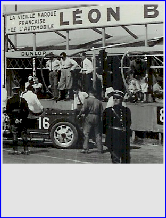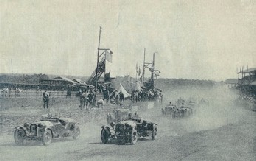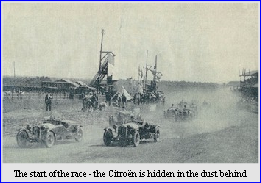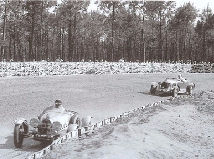Citroen C4 Le Mans - Copyright 2010






Three laps of History for a Citroën at Le Mans.
It is the eighteenth of June 1932. It is hot, very hot. The time is approaching four o’clock in the afternoon, fast. 27 year old Henri de la Sayette is standing on the pit counter of car number 19, anxiously watching as Charles Wolf finishes the work he is doing to get the car fired up. The car is a Citroën C4 Roadster and they are about to start the famous 24-hour race at Le Mans. The only Citroën ever to have done so before or since.
Raymond Sommer in the Alfa no 8 in the next pit had saluted Henri as he went out to take his place on the grid. Hellé Nice, who was there to watch for the weekend, had rushed past and kissed both of them wishing them a good race. Just in front of them, already on the grid, in Bugatti no 16 was Ernest Friderich, long term friend and right hand man of Ettore Bugatti and Bugatti concessionaire in Nice, who was thinking of his daughter Renée who had been killed 4 months earlier on the Pougues-les-Eaux hillclimb part of the St Raphael rally – she might have been racing here. But that was life and racing in those days.

Henri de la Sayette on pit wall in plus fours with Charles Wolf in white overalls ( back to us), working on the Citroën which is hidden behind Bugatti no 16.

At last the Citroën runs. Charles makes a few adjustments, puts the bonnets down and fastens the straps. “Good – get going – quick!” shouts Henri, and Charles drives the Citroën forward onto the circuit, along in front of some of the assembled cars and reverses it into its allotted place on the grid, where he gets out. Henri joins him and they chat nervously as they mop their brows in the heat – “Have you remembered this?”, “Did you do that?”….
Then it is time for Henri to move back to the pit counters with everyone else, apart from the drivers, including Charles Wolf, who walk across the track and take up their positions opposite their cars.
Just before four o’clock there is an announcement requesting one minute of silence in memory of André Boillot (a very popular and successful French racing driver) who had died a week previously in another event.
The silence over, the crowd press forward against the picket fence to watch as the flag is dropped, but some drivers have anticipated it, so they are waved back. Again they start running too early and are waved back. At last the clerk of the course shouts “Partez!” and drops the big yellow flag and the drivers run across to their cars, jump in and press their starters. With a roar of engines and taking off in any order, they race up to the first corner.
Charles was slow getting into the car, but has got a good start and the car is going well. The dust is horrendous going up to the foot bridge. He passes an Alfa, but is quickly re-passed by the same car. Then going through the Esses, he passes the Caban which seemed to be slowing.




Approaching Maison Blanche, he sees a big car on its side and men starting to run to push it out of the way. Can’t see the driver. They race past the pits and he waves at Henri to show all is well. A Bugatti appears from nowhere beside him, like he’s standing still – where did he come from? Going into the Esses, the Bugatti starts to pull away.
“I’ve got to keep up with him, otherwise I’ll fall right back”, thought Charles. He sees the Caban parked on the side of the Mulsanne straight Next time past Maison Blanche, there are men trying to put a rope onto the Bentley. And going past the pits there are two more cars stopped for repairs. Another lap completed. He manages to keep the Bugatti in sight. They are still trying to pull the heavy Bentley off the circuit into a field. Another lap completed.
Through the Esses, round Tertre Rouge and towards Mulsanne. Suddenly, above the noise of the straining engine, there’s a clunk, and a banging, and the car starts to misfire. “Merde! Merde! Merde!” shouts Charles, as he tries to coax the car onwards to get back to the pits.
The car coasts to a halt on the side of the track and Charles jumps out. Some men arrive to help, but he is the only one who is allowed to work on the car, so they mustn’t touch it. He frantically undoes the straps and opens the bonnet – disaster, something has broken!.
That’s it – he has nothing to repair or replace it with! Totally dejected, he allows the men to push the car right into the field, to get off the circuit, and sits on the ground by the car, as a mixture of adrenalin and fatigue rush to his head. “My God – that’s it – we’re finished!” he says to the assembled helpers. A couple of them look at the engine, and agree, shrug their shoulders, and the men go back to watching the race, leaving Charles alone with Henri’s Citroën.
So ends the race and dreams of Henri de la Sayette and Charles Wolf. Competing against Europe’s best in one of the most difficult motor races. A simple fault, which they could not fix.
The facts.
For 1932 the circuit had been shortened to 13.5 kilometres. 32 cars were entered of which 26 cars started - several Alfas, a Talbot, 3 Aston Martins, 4 Bugattis, an Amilcar, a Caban Special, a Salmson, an MG, 1 Mercedes-Benz, a Stutz, a B.N.C., a Rally N.C.P., 1 Bentley, and a Citroën. Raymond Sommer and Luigi Chinetti won in an Alfa Romeo 8C 2300 LM, with an average lap of 123 km/hour.
The fastest lap was by Ferdinando Minoia in an Alfa at 142 kph - but he only lasted 22 laps and crashed!
There was only 1 lady driver this year - Odette Siko in an Alfa Romeo 8C 1750 driving with Louis Charaval who came 4th overall and won their class,
Only 9 cars finished the race.
More Information
I will be adding more information as I find it - if anyone has any further information or photos, please let me know.